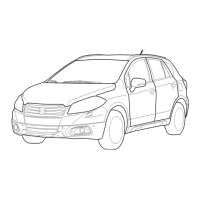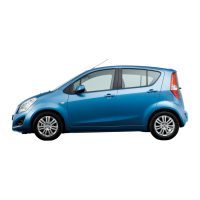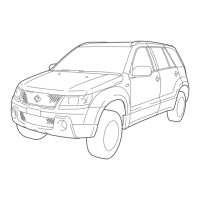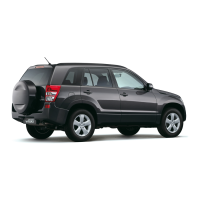Do you have a question about the Suzuki Ciaz series and is the answer not in the manual?
Explains signal words used for warnings, cautions, notices, and notes in the manual.
Warns against modifying the vehicle and potential warranty voidance.
Advises caution for improper installation of mobile communication equipment.
Discusses the impact of non-genuine parts on vehicle performance and warranty coverage.
Forbids re-use of safety-hazardous items like airbags and seat belts.
Details the vehicle's keys, immobilizer system, and key identification numbers.
Explains how to lock and unlock vehicle doors using side door locks and central locking systems.
Describes rear door child-proof locks and how to open the trunk lid.
Details the functions of keyless entry and push start system remote controllers and transmitters.
Explains the operation of electric window controls, including auto-down/up and pinching prevention.
Provides instructions for adjusting the driver's seat position, seatback angle, and seat height.
Discusses head restraint adjustment for front and rear seats and general safety precautions.
Covers seat belt usage, child restraint systems, and important safety warnings related to them.
Details the vehicle's supplemental restraint system, including front air bags and seat belt pretensioners.
Explains the various indicators and gauges found in the instrument cluster, such as speedometer, fuel gauge, and warning lights.
Warns about the dangers of breathing exhaust gases and provides safety precautions.
Provides a checklist for essential daily vehicle inspections before driving.
Explains normal engine oil consumption and factors affecting it, including a maximum consumption rate.
Describes the functions of the ignition switch and its four positions: LOCK, ACC, ON, and START.
Explains the operation of the engine switch for LOCK, ACC, ON, and START modes, including safety warnings.
Details how to use the transaxle, including manual and CVT operations, and driving tips.
Provides important precautions for the initial 960 km of vehicle operation to ensure engine reliability.
Explains the function of the catalytic converter and the importance of using unleaded fuel and proper engine tuning.
Offers instructions to help improve fuel economy, focusing on avoiding excessive idling and fast starts, and maintaining steady speeds.
Provides advice for highway driving, including stopping distance, hydroplaning, side winds, and hill driving.
Offers guidance for driving on slippery roads, emphasizing reduced speed, avoiding sudden maneuvers, and proper tire chain usage.
Provides instructions for freeing a stuck vehicle and advice on when to seek professional assistance or towing.
Details the location and operation of the fuel filler cap, including safety precautions for removal.
Explains how to open and close the engine hood safely, with cautions regarding hot components and wiper arms.
Describes the function and adjustment of the sun visors, including card holders and vanity mirrors, with safety warnings.
Explains the operation of the interior lights, including instrument panel pocket, front, center, and trunk lid lights.
Details the operation of the trunk light and provides a notice about not leaving the trunk lid open for extended periods.
Explains how to use accessory and AUX/USB sockets for electrical devices and audio playback.
Explains the use of coat hooks and the glove box, with safety warnings regarding open lids.
Details the location and use of various storage areas, including cup holders, pockets, and armrest console box, with safety warnings.
Explains the use of the footrest as a support for the left foot.
Describes the location and proper use of front and rear frame hooks for emergency situations and towing, with warnings against improper use.
Introduces the two types of climate control systems: manual and automatic, and their basic functions.
Details the controls for the manual air conditioning system, including temperature, blower speed, and air flow selectors.
Explains the controls for the automatic climate control system, including temperature, blower speed, and air intake selectors.
Describes the printed antenna and advises consulting a dealer before installing radio transmitters.
Provides an overview of the AM/FM CD Player controls and basic operations.
Covers basic operations of the audio system, including power, volume, and mute functions.
Explains how to adjust sound settings like bass, treble, balance, fader, AVC, and Preset-EQ.
Explains how to select radio bands, seek tuning, manual tuning, preset memory, and auto store functions.
Covers loading, ejecting, selecting tracks, and fast forwarding/rewinding a CD, along with playback modes.
Details how to select folders, tracks, and manage playback modes for MP3, WMA, and AAC discs.
Explains how to select USB device modes, folders, and tracks for playback, including random and repeat playback options.
Covers selecting iPod modes, tracks, and managing playback options, including random and repeat playback.
Explains how to register phones, receive calls, end calls, reject calls, and adjust volumes for Bluetooth® hands-free functionality.
Provides instructions for phone registration, call handling, volume adjustment, and deleting entries.
Details selecting Bluetooth® audio modes, folders, and tracks for playback, including device registration.
Guides on selecting, listing, and deleting audio devices and managing Passkey settings in the Bluetooth® system.
Details how to set, cancel, and confirm the Personal Identification Number (PIN) for the anti-theft function of the audio system.
Explains vehicle weight capacities, including GVWR and PAW, and the importance of proper loading.
Advises against towing trailers due to potential negative impacts on handling, durability, and fuel economy.
Provides instructions and a table for safely towing the vehicle behind a motorhome, specifying methods for CVT and manual transaxle vehicles.
Outlines the recommended regular maintenance schedule based on mileage and months, indicating services for engine, ignition, fuel, and emission systems.
Explains how to check drive belt tension, its importance for vehicle systems, and when to seek professional replacement.
Details the specified engine oil, its viscosity, and the procedure for checking and changing engine oil and filter, including safety warnings.
Discusses the selection, level check, and addition of engine coolant, including important notices and warnings.
Explains the importance of a clean air cleaner and recommends professional spark plug service.
Details the recommended gear oil, its viscosity, and the procedure for checking the gear oil level.
Covers checking the clutch pedal and CVT fluid level, with advice on when to seek dealer inspection.
Guides on checking brake fluid level, brake pedal height, and parking brake adjustment, with safety warnings.
Explains how to check steering wheel play and tire condition, including air pressure and tread depth.
Advises on tire rotation for even wear and provides battery maintenance and safety precautions.
Details the types of fuses and provides instructions on how to remove and replace them using the fuse puller.
Explains the ABS, Brake System, Air Bag, and Malfunction Indicator lights and their implications.
Provides step-by-step instructions for replacing headlight bulbs and other general lights.
Instructs on checking and refilling the windshield washer fluid reservoir, with warnings against using antifreeze solutions.
Offers maintenance tips for the air conditioning system, including periodic operation and filter replacement, with notices about refrigerant.
Identifies the tools for changing tires and provides crucial instructions for safely jacking up the vehicle.
Details the step-by-step procedure for safely changing a wheel, including tightening nuts to the specified torque.
Explains where the kit is stored, its contents, and cases where it cannot be used, along with important precautions.
Provides detailed, safe procedures for jump starting a vehicle with a weak or flat battery, including warnings and notices.
Advises contacting professional services for towing and provides methods for towing CVT and manual transaxle vehicles.
Offers troubleshooting steps for starter issues and flooded engines, including safety precautions.
Guides on what to do if the engine overheats, including checking coolant level and seeking dealer assistance.
Offers instructions and information on common causes and environmental factors that accelerate corrosion, and how to prevent it.
Provides comprehensive guidance on cleaning the exterior and interior of the vehicle, including specific instructions for different materials and safety warnings.
Provides specific instructions and warnings for cleaning aluminum wheels to avoid damage and discoloration.
Recommends waxing and polishing the vehicle's paint for protection and beautification, advising the use of quality products and following manufacturer instructions.
Explains the importance of chassis and engine serial numbers for registration and service, and where to find them.
Lists the overall dimensions of the vehicle, including length, width, height, wheelbase, track, and ground clearance.
Details the vehicle's mass specifications, including curb weight, gross vehicle weight rating, and permissible axle weights.
Provides technical specifications for the engine, including type, number of cylinders, bore, stroke, displacement, and compression ratio.
Lists the wattage and bulb numbers for various vehicle lights, including headlights, fog lights, turn signals, and interior lights.
Specifies tire sizes, rim sizes, tire pressures, and recommended snow tires, with advice on tire replacement and potential issues.
Lists recommended fuel, engine oil, coolant, transaxle oil, and brake/clutch fluid capacities, along with specifications.
Explains signal words used for warnings, cautions, notices, and notes in the manual.
Warns against modifying the vehicle and potential warranty voidance.
Advises caution for improper installation of mobile communication equipment.
Discusses the impact of non-genuine parts on vehicle performance and warranty coverage.
Forbids re-use of safety-hazardous items like airbags and seat belts.
Details the vehicle's keys, immobilizer system, and key identification numbers.
Explains how to lock and unlock vehicle doors using side door locks and central locking systems.
Describes rear door child-proof locks and how to open the trunk lid.
Details the functions of keyless entry and push start system remote controllers and transmitters.
Explains the operation of electric window controls, including auto-down/up and pinching prevention.
Provides instructions for adjusting the driver's seat position, seatback angle, and seat height.
Discusses head restraint adjustment for front and rear seats and general safety precautions.
Covers seat belt usage, child restraint systems, and important safety warnings related to them.
Details the vehicle's supplemental restraint system, including front air bags and seat belt pretensioners.
Explains the various indicators and gauges found in the instrument cluster, such as speedometer, fuel gauge, and warning lights.
Warns about the dangers of breathing exhaust gases and provides safety precautions.
Provides a checklist for essential daily vehicle inspections before driving.
Explains normal engine oil consumption and factors affecting it, including a maximum consumption rate.
Describes the functions of the ignition switch and its four positions: LOCK, ACC, ON, and START.
Explains the operation of the engine switch for LOCK, ACC, ON, and START modes, including safety warnings.
Details how to use the transaxle, including manual and CVT operations, and driving tips.
Provides important precautions for the initial 960 km of vehicle operation to ensure engine reliability.
Explains the function of the catalytic converter and the importance of using unleaded fuel and proper engine tuning.
Offers instructions to help improve fuel economy, focusing on avoiding excessive idling and fast starts, and maintaining steady speeds.
Provides advice for highway driving, including stopping distance, hydroplaning, side winds, and hill driving.
Offers guidance for driving on slippery roads, emphasizing reduced speed, avoiding sudden maneuvers, and proper tire chain usage.
Provides instructions for freeing a stuck vehicle and advice on when to seek professional assistance or towing.
Details the location and operation of the fuel filler cap, including safety precautions for removal.
Explains how to open and close the engine hood safely, with cautions regarding hot components and wiper arms.
Describes the function and adjustment of the sun visors, including card holders and vanity mirrors, with safety warnings.
Explains the operation of the interior lights, including instrument panel pocket, front, center, and trunk lid lights.
Details the operation of the trunk light and provides a notice about not leaving the trunk lid open for extended periods.
Explains how to use accessory and AUX/USB sockets for electrical devices and audio playback.
Explains the use of coat hooks and the glove box, with safety warnings regarding open lids.
Details the location and use of various storage areas, including cup holders, pockets, and armrest console box, with safety warnings.
Explains the use of the footrest as a support for the left foot.
Describes the location and proper use of front and rear frame hooks for emergency situations and towing, with warnings against improper use.
Introduces the two types of climate control systems: manual and automatic, and their basic functions.
Details the controls for the manual air conditioning system, including temperature, blower speed, and air flow selectors.
Explains the controls for the automatic climate control system, including temperature, blower speed, and air intake selectors.
Describes the printed antenna and advises consulting a dealer before installing radio transmitters.
Provides an overview of the AM/FM CD Player controls and basic operations.
Covers basic operations of the audio system, including power, volume, and mute functions.
Explains how to adjust sound settings like bass, treble, balance, fader, AVC, and Preset-EQ.
Explains how to select radio bands, seek tuning, manual tuning, preset memory, and auto store functions.
Covers loading, ejecting, selecting tracks, and fast forwarding/rewinding a CD, along with playback modes.
Details how to select folders, tracks, and manage playback modes for MP3, WMA, and AAC discs.
Explains how to select USB device modes, folders, and tracks for playback, including random and repeat playback options.
Covers selecting iPod modes, tracks, and managing playback options, including random and repeat playback.
Explains how to register phones, receive calls, end calls, reject calls, and adjust volumes for Bluetooth® hands-free functionality.
Provides instructions for phone registration, call handling, volume adjustment, and deleting entries.
Details selecting Bluetooth® audio modes, folders, and tracks for playback, including device registration.
Guides on selecting, listing, and deleting audio devices and managing Passkey settings in the Bluetooth® system.
Details how to set, cancel, and confirm the Personal Identification Number (PIN) for the anti-theft function of the audio system.
Explains vehicle weight capacities, including GVWR and PAW, and the importance of proper loading.
Advises against towing trailers due to potential negative impacts on handling, durability, and fuel economy.
Provides instructions and a table for safely towing the vehicle behind a motorhome, specifying methods for CVT and manual transaxle vehicles.
Outlines the recommended regular maintenance schedule based on mileage and months, indicating services for engine, ignition, fuel, and emission systems.
Explains how to check drive belt tension, its importance for vehicle systems, and when to seek professional replacement.
Details the specified engine oil, its viscosity, and the procedure for checking and changing engine oil and filter, including safety warnings.
Discusses the selection, level check, and addition of engine coolant, including important notices and warnings.
Explains the importance of a clean air cleaner and recommends professional spark plug service.
Details the recommended gear oil, its viscosity, and the procedure for checking the gear oil level.
Covers checking the clutch pedal and CVT fluid level, with advice on when to seek dealer inspection.
Guides on checking brake fluid level, brake pedal height, and parking brake adjustment, with safety warnings.
Explains how to check steering wheel play and tire condition, including air pressure and tread depth.
Advises on tire rotation for even wear and provides battery maintenance and safety precautions.
Details the types of fuses and provides instructions on how to remove and replace them using the fuse puller.
Explains the ABS, Brake System, Air Bag, and Malfunction Indicator lights and their implications.
Provides step-by-step instructions for replacing headlight bulbs and other general lights.
Instructs on checking and refilling the windshield washer fluid reservoir, with warnings against using antifreeze solutions.
Offers maintenance tips for the air conditioning system, including periodic operation and filter replacement, with notices about refrigerant.
Identifies the tools for changing tires and provides crucial instructions for safely jacking up the vehicle.
Details the step-by-step procedure for safely changing a wheel, including tightening nuts to the specified torque.
Explains where the kit is stored, its contents, and cases where it cannot be used, along with important precautions.
Provides detailed, safe procedures for jump starting a vehicle with a weak or flat battery, including warnings and notices.
Advises contacting professional services for towing and provides methods for towing CVT and manual transaxle vehicles.
Offers troubleshooting steps for starter issues and flooded engines, including safety precautions.
Guides on what to do if the engine overheats, including checking coolant level and seeking dealer assistance.
Offers instructions and information on common causes and environmental factors that accelerate corrosion, and how to prevent it.
Provides comprehensive guidance on cleaning the exterior and interior of the vehicle, including specific instructions for different materials and safety warnings.
Provides specific instructions and warnings for cleaning aluminum wheels to avoid damage and discoloration.
Recommends waxing and polishing the vehicle's paint for protection and beautification, advising the use of quality products and following manufacturer instructions.
Explains the importance of chassis and engine serial numbers for registration and service, and where to find them.
Lists the overall dimensions of the vehicle, including length, width, height, wheelbase, track, and ground clearance.
Details the vehicle's mass specifications, including curb weight, gross vehicle weight rating, and permissible axle weights.
Provides technical specifications for the engine, including type, number of cylinders, bore, stroke, displacement, and compression ratio.
Lists the wattage and bulb numbers for various vehicle lights, including headlights, fog lights, turn signals, and interior lights.
Specifies tire sizes, rim sizes, tire pressures, and recommended snow tires, with advice on tire replacement and potential issues.
Lists recommended fuel, engine oil, coolant, transaxle oil, and brake/clutch fluid capacities, along with specifications.
| Brand | Suzuki |
|---|---|
| Model | Ciaz series |
| Category | Automobile |
| Language | English |












